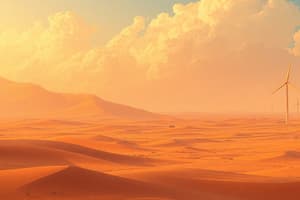Podcast
Questions and Answers
What percentage of the Thar Desert area is cultivated?
What percentage of the Thar Desert area is cultivated?
- 40%
- 20% (correct)
- 10%
- 30%
Which method is primarily used to manage water scarcity in the Thar Desert?
Which method is primarily used to manage water scarcity in the Thar Desert?
- Deep well drilling
- Rainwater harvesting from clouds
- River damming
- Dug pits for rainwater retention (correct)
Which crop is NOT commonly grown in the Thar Desert?
Which crop is NOT commonly grown in the Thar Desert?
- Rice (correct)
- Guar
- Chillies
- Watermelons
What is one consequence of the lack of water in the Thar Desert region?
What is one consequence of the lack of water in the Thar Desert region?
During which months does rainfall typically occur in the Thar Desert?
During which months does rainfall typically occur in the Thar Desert?
What factor exacerbates poverty in the Thar Desert region?
What factor exacerbates poverty in the Thar Desert region?
How do traditional farmers collect rainwater in the Thar Desert?
How do traditional farmers collect rainwater in the Thar Desert?
What future solution could enhance crop production in the Thar Desert?
What future solution could enhance crop production in the Thar Desert?
Flashcards
Thar Desert Location
Thar Desert Location
The Thar Desert is situated in southeastern Pakistan, encompassing approximately 22,000 square kilometers.
Thar Desert Agriculture
Thar Desert Agriculture
The Thar Desert has a unique agricultural system, with about 20% of its area cultivated. Crops like guar, millet, mung beans, and sesame are grown, while the remaining 80% of cultivated land is used for fodder crops.
Water Scarcity in Thar
Water Scarcity in Thar
Water scarcity is a major challenge in the Thar Desert. High temperatures and low rainfall result in limited water availability, often forcing women to travel long distances for water.
Traditional Water Management
Traditional Water Management
Signup and view all the flashcards
Impact of Water Scarcity
Impact of Water Scarcity
Signup and view all the flashcards
Future Prospects for Thar
Future Prospects for Thar
Signup and view all the flashcards
Challenges of Seasonal Variations
Challenges of Seasonal Variations
Signup and view all the flashcards
Role of Ports in Thar
Role of Ports in Thar
Signup and view all the flashcards
Study Notes
Life and Economy in Thar Desert
- Thar Desert, located in southeastern Pakistan, covers approximately 22,000 sq km.
- Approximately 20% of the land is cultivated.
- Major crops include: wheat, millet, mung beans, kidney beans, sesame, watermelons, and castor seeds. Fodder crops also are grown.
- Crop yields depend largely on rainfall, with only a few areas benefiting from irrigation.
- Traditional farming techniques, such as collecting rainwater in ponds and tanks, are used.
Water Scarcity
- Rainfall is erratic and unpredictable, with periods of heavy showers followed by long droughts.
- High temperatures and high evaporation rates lead to water scarcity.
- Limited groundwater recharge, also an issue.
- Water is a scarce commodity in the desert.
Traditional Water Collection
- Farmers dig pits, use traditional techniques to retain rainwater in sandy soil.
- Rainwater is collected in containers, jars, and household vessels (e.g., "pucca" house rooftops).
- Local communities store rainwater for various uses.
Challenges
- Food shortages are a consequence of water scarcity.
- Poverty, risk to life, and danger to livestock.
- Farmers' activities are declining due to water scarcity and unpredictable rainfall.
- Peasants and farmers depend on local crops and grazing animals.
- Herbs and local shrubs provide natural resources for food and fuel.
Future Prospects
- Establishing seasonal tree plantations and creating barrages to collect floodwaters and bring more water to the area.
- Barrages are a method of bringing floodwater to the region, increasing food production.
- Increase in water availability for human needs and create green spaces.
- Potential for tourism due to increased greenery in the desert.
Studying That Suits You
Use AI to generate personalized quizzes and flashcards to suit your learning preferences.




